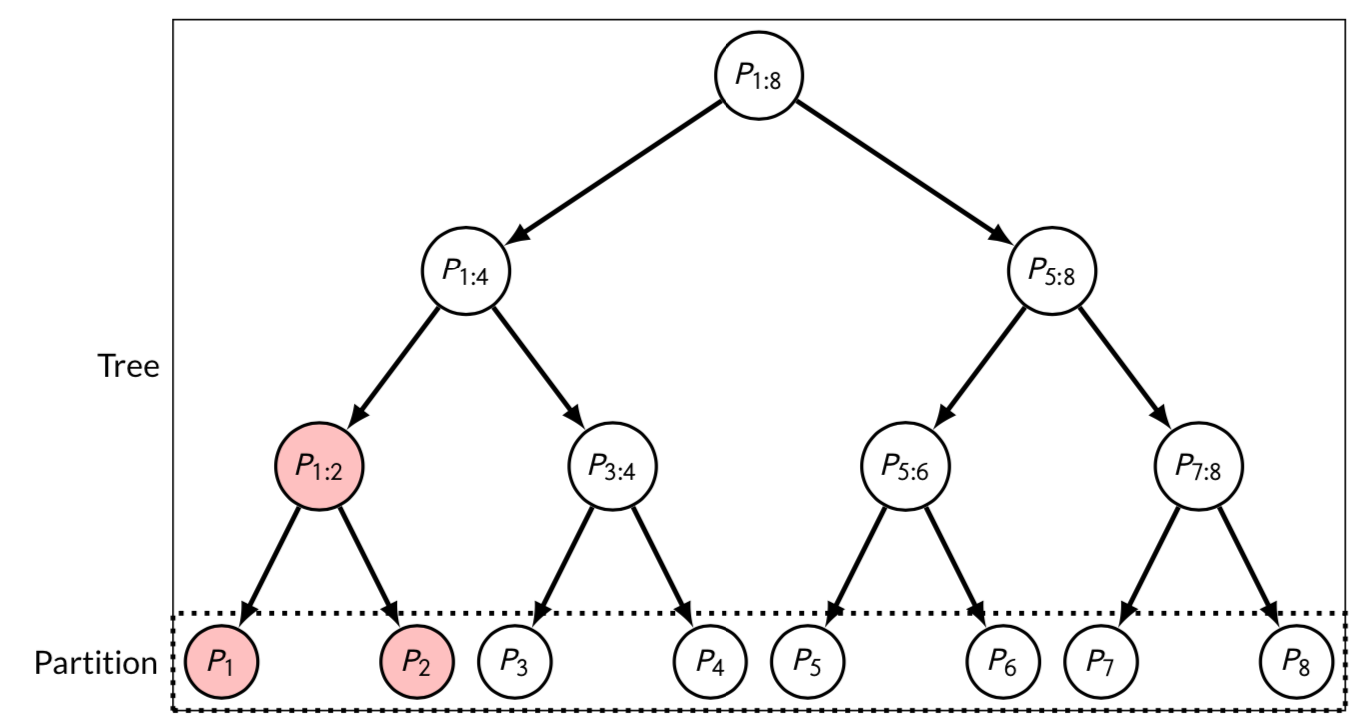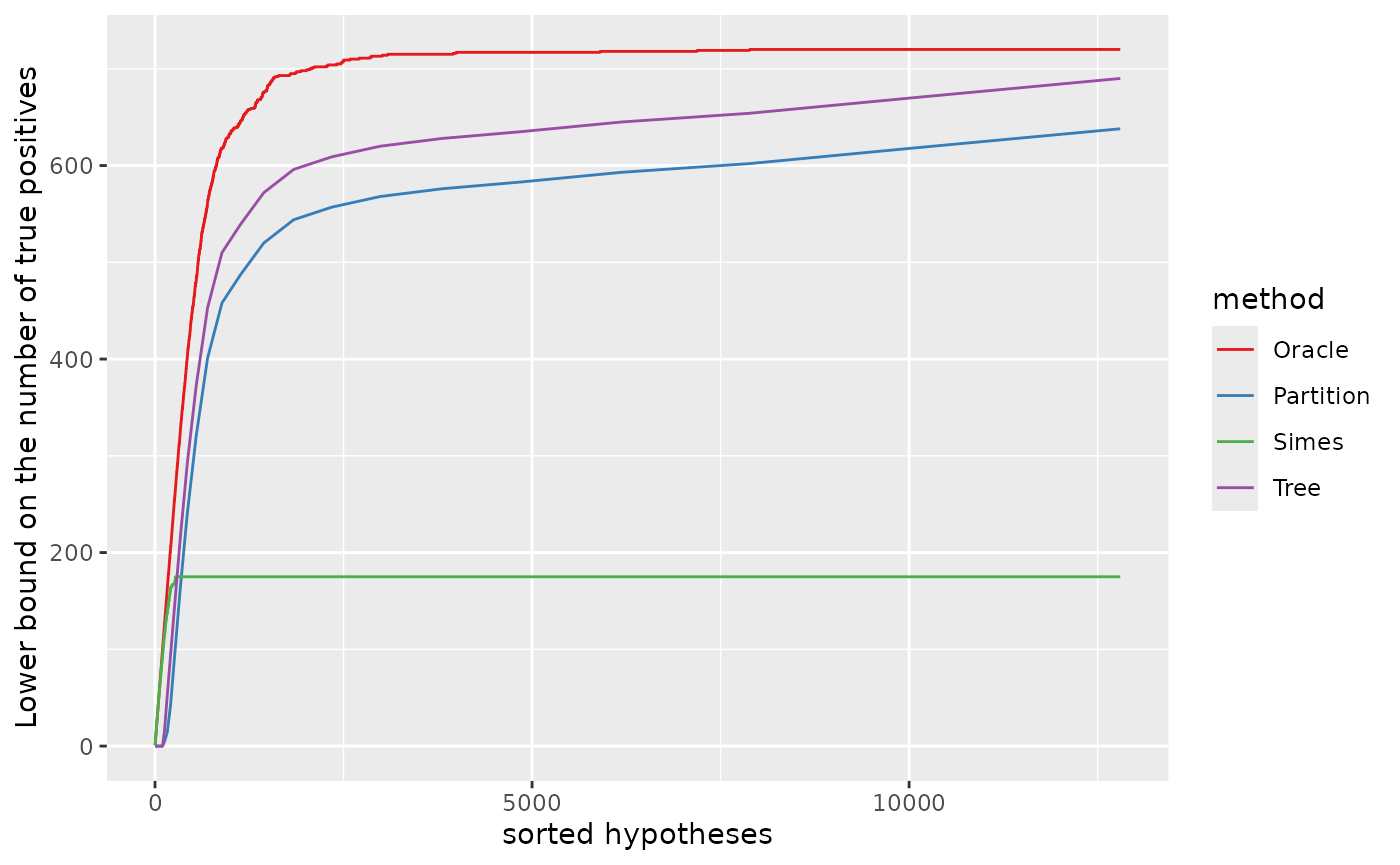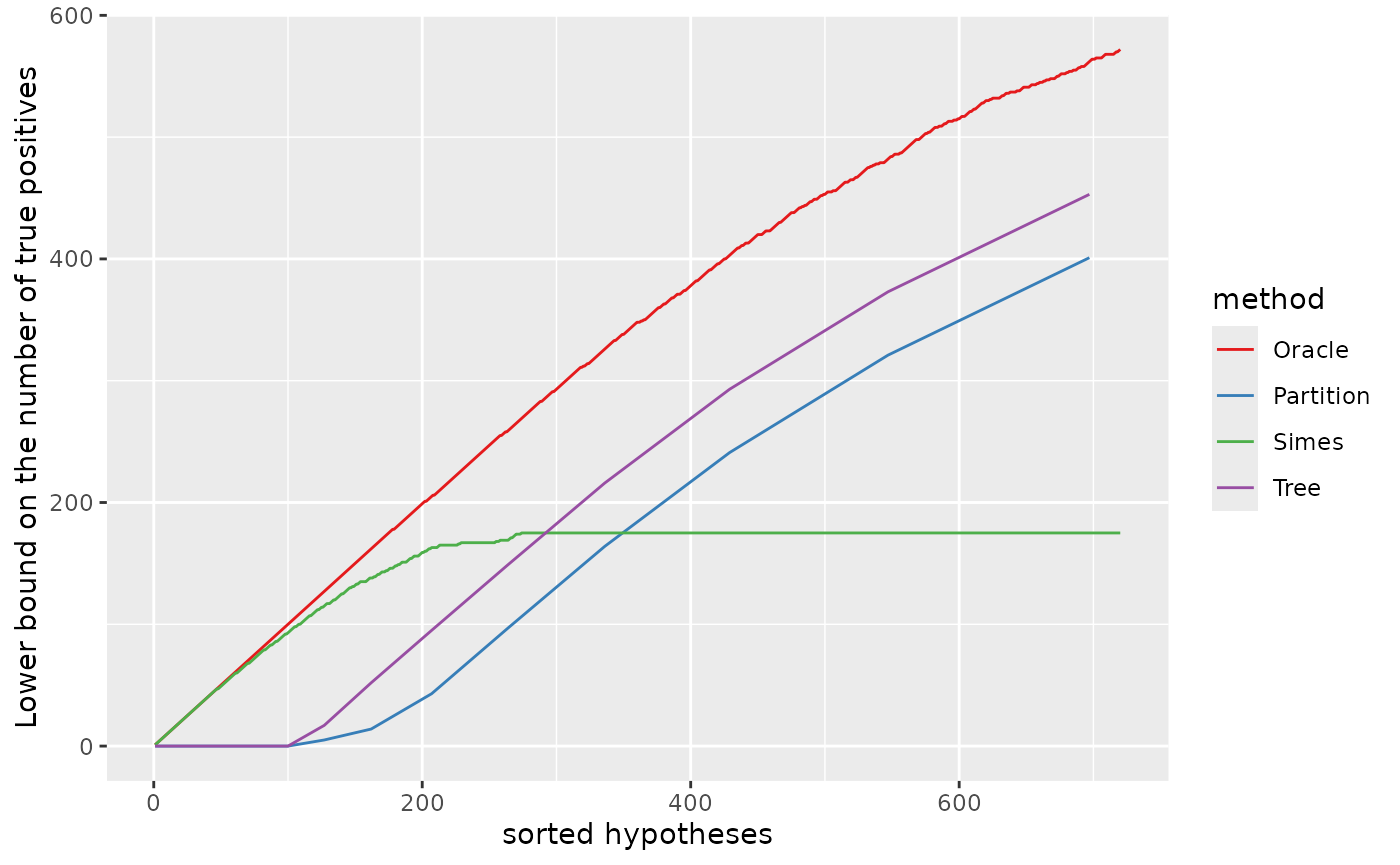Confidence curves for structured hypotheses
G. Durand, G. Blanchard, P. Neuvial, E. Roquain
2025-07-25
Source:vignettes/confidenceCurves_localized.Rmd
confidenceCurves_localized.RmdIntroduction
The goal of this vignette is to illustrate the post hoc bounds on the
number of true/false positives proposed in Durand
et al. (2020) for localized signals. More specifically, we
reproduce one of the plots of Figure 12 in Durand
et al. (2020) using the R package sanssouci. We will
explicitly quote Durand et al. (2020) when
relevant.
Objective
We consider null ordered hypotheses partitioned in intervals of size . For simplicity we set the number of intervals to be a power of 2: for some integer :
s <- 100
q <- 7
m <- s*2^qTherefore, we have .Our goal is to compare three post hoc bounds. These bounds are obtained by interpolation from a reference family where the amount of signal is estimated by probabilistic inequalities, following the general principle laid down by Blanchard, Neuvial, and Roquain (2020), and they differ by the choice of the reference family:
“Simes”: the bound derived from the Simes (1986) inequality as proposed by Goeman and Solari (2011) and further studied by Blanchard, Neuvial, and Roquain (2020). This bound was introduced in a context where the signal is not localized.
“Tree” and “Partition”: two bounds derived from the DKWM inequality (Dvoretzky, Kiefer, and Wolfowitz (1956), Massart (1990)), as proposed in Durand et al. (2020). For the “Partition” bound, the reference family is the original partition of the null hypotheses into intervals. For the “Tree” bound, the reference family is the perfect binary tree whose leaves are the elements of the original partition.
Settings
We define the following numerical parameters, which characterize the true/false null hypothesis configuration considered in Section 5 of Durand et al. (2020):
K1 <- 8
r <- 0.9
m1 <- r*K1*s
barmu <- 3More precisely, quoting Durand et al. (2020):
the false null hypotheses are contained in for , for some fixed value of . The quantity is defined similarly as in (20), as the fraction of false null hypotheses in those , and is set to . All of the other partition pieces only contain true null hypotheses.
We start by creating a binary tree structure and generating the signal:
obj <- SansSouciDyadic(m, leaf_size = s, direction = "top-down")
mu <- gen.mu.leaves(m = m, K1 = K1, d = r, grouped = TRUE, setting = "const",
barmu = barmu, leaf_list = obj$input$leaves)This construction is illustrated in the figure below (Figure 11 in Durand et al. (2020)) in the case where .

Figure 11 in Durand et al.
We generate -values according to the simulation setup in Durand et al. (2020):
The true null -values are distributed as i.i.d. , and false null -values are distributed as i.i.d. , where [].
pvalues <- gen.p.values(m = m, mu = mu, rho = 0, alternative = "greater")Calculate confidence curves
The confidence level for post hoc inference is set to .
alpha <- 0.05Below, we will be considering confidence curves of the form , where is the set of the smallest -values (regardless of the ordering given by the partition). Note that focusing on such sets is a priori favorable to the Simes bound, for which the elements of the reference family are among the .
1- True number of false positives
The true number of false positives will be called “Oracle” bound in the plots below.
obj$input$truth <- as.numeric(mu != 0)
res_Oracle <- fit(obj, alpha = alpha, p.values = pvalues, family = "Oracle")
res[["Oracle"]] <- predict(res_Oracle, what = "FP", all = TRUE)
res[["Oracle"]]$method <- "Oracle"2- Simes-based confidence curve
Here we use the Simes (1986) inequality to bound the number of false positives in each node of the tree, as proposed by Goeman and Solari (2011) and further studied by Blanchard, Neuvial, and Roquain (2020), both in a context where the signal is not localized.
3- DKWM-based confidence curve
Here we use the DKWM inequality (Dvoretzky, Kiefer, and Wolfowitz (1956), Massart (1990)) to bound the number of false positives in each node of the tree, as suggested in Durand et al. (2020).
Plot confidence curves
library("ggplot2")
dat <- Reduce(rbind, res)
lvls <- c("Oracle", "Partition", "Simes", "Tree", "Hybrid")
cols <- RColorBrewer::brewer.pal(length(lvls), "Set1")
names(cols) <- lvlsUpper bound on the number of false positives
xymax <- m1;
pV <- ggplot(dat, aes(x, bound, colour = method)) +
geom_line() +
ylab("Upper bound on the number of false positives") +
xlab("sorted hypotheses") +
scale_colour_manual(values = cols)
pV
The “Tree” and “Partition” bounds are sharper than the “Simes” bound as soon as we are considering “large” sets of hypotheses. The fact that the “Tree” and “Partition” bounds are not as sharp as the “Simes” bound for the first hundred of hypotheses can be explained by our choice of the ordering of the null hypotheses in the sets , which as discussed above is favorable to the “Simes” bound.
Zooming on the first 720 null hypotheses (in the order of the -values):
pV + coord_cartesian(xlim = c(1, xymax),
ylim = c(0, xymax))
Lower bound on the number of true positives
The same information can be displayed as a lower bound on the number of true positives, defined for any by :
dat$S <- dat$x - dat$bound
xmax <- m1;
ymax <- max(dat$S[m1]);
pS <- ggplot(dat, aes(x, S, colour = method)) +
geom_line() +
ylab("Lower bound on the number of true positives") +
xlab("sorted hypotheses") +
scale_colour_manual(values = cols)
pS
Zooming in the first 720 null hypotheses (in the order of the -values), we recover the middle plot in Figure 12 of Durand et al. (2020).

Session information
## R version 4.5.1 (2025-06-13)
## Platform: x86_64-pc-linux-gnu
## Running under: Ubuntu 24.04.2 LTS
##
## Matrix products: default
## BLAS: /usr/lib/x86_64-linux-gnu/openblas-pthread/libblas.so.3
## LAPACK: /usr/lib/x86_64-linux-gnu/openblas-pthread/libopenblasp-r0.3.26.so; LAPACK version 3.12.0
##
## locale:
## [1] LC_CTYPE=C.UTF-8 LC_NUMERIC=C LC_TIME=C.UTF-8
## [4] LC_COLLATE=C.UTF-8 LC_MONETARY=C.UTF-8 LC_MESSAGES=C.UTF-8
## [7] LC_PAPER=C.UTF-8 LC_NAME=C LC_ADDRESS=C
## [10] LC_TELEPHONE=C LC_MEASUREMENT=C.UTF-8 LC_IDENTIFICATION=C
##
## time zone: UTC
## tzcode source: system (glibc)
##
## attached base packages:
## [1] stats graphics grDevices utils datasets methods base
##
## other attached packages:
## [1] ggplot2_3.5.2 sanssouci_0.16.0
##
## loaded via a namespace (and not attached):
## [1] vctrs_0.6.5 cli_3.6.5 knitr_1.50 rlang_1.1.6
## [5] xfun_0.52 generics_0.1.4 textshaping_1.0.1 jsonlite_2.0.0
## [9] labeling_0.4.3 glue_1.8.0 htmltools_0.5.8.1 ragg_1.4.0
## [13] sass_0.4.10 scales_1.4.0 rmarkdown_2.29 grid_4.5.1
## [17] tibble_3.3.0 evaluate_1.0.4 jquerylib_0.1.4 fastmap_1.2.0
## [21] matrixTests_0.2.3 yaml_2.3.10 lifecycle_1.0.4 compiler_4.5.1
## [25] RColorBrewer_1.1-3 fs_1.6.6 pkgconfig_2.0.3 farver_2.1.2
## [29] systemfonts_1.2.3 lattice_0.22-7 digest_0.6.37 R6_2.6.1
## [33] pillar_1.11.0 magrittr_2.0.3 bslib_0.9.0 Matrix_1.7-3
## [37] withr_3.0.2 gtable_0.3.6 tools_4.5.1 matrixStats_1.5.0
## [41] pkgdown_2.1.3 cachem_1.1.0 desc_1.4.3